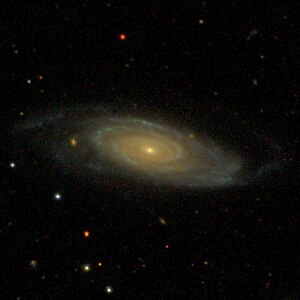NGC 4357
| Galaxy NGC 4357 / NGC 4381 |
|
|---|---|

|
|
| SDSS recording | |
| AladinLite | |
| Constellation | Hunting dogs |
|
Position equinox : J2000.0 , epoch : J2000.0 |
|
| Right ascension | 12 h 23 m 58.8 s |
| declination | + 48 ° 46 ′ 46 ″ |
| Appearance | |
| Morphological type | SAbc / LINER |
| Brightness (visual) | 12.4 mag |
| Brightness (B-band) | 13.2 mag |
| Angular expansion | 3.7 ′ × 1.3 ′ |
| Position angle | 77 ° |
| Surface brightness | 14.0 mag / arcmin² |
| Physical data | |
| Redshift | 0.013750 ± 0.000020 |
| Radial velocity | 4122 ± 6 km / s |
|
Stroke distance v rad / H 0 |
(187 ± 13) x 10 6 ly (57.4 ± 4.0) Mpc |
| history | |
| discovery | Wilhelm Herschel |
| Discovery date | February 9, 1788 |
| Catalog names | |
| NGC 4357 • NGC 4381 • UGC 7478 • PGC 40296 • CGCG 244-010 • MCG + 08-23-017 • 2MASX J12235883 + 4846454 • GC 2945 • H II 743 • GALEX ASC J122358.67 + 484646.1 | |
NGC 4357 = NGC 4381 is a spiral galaxy with an active nucleus of the Hubble type Sbc in the constellation Hounds in the northern sky . It is around 187 million light years away from the Milky Way and has a diameter of around 200,000 light years .
On January 16, 1996, Alessandro Gabrijelcic discovered the Type IIb supernova SN 1996B in it.
The object was discovered on February 9, 1788 by the German-British astronomer Wilhelm Herschel .
